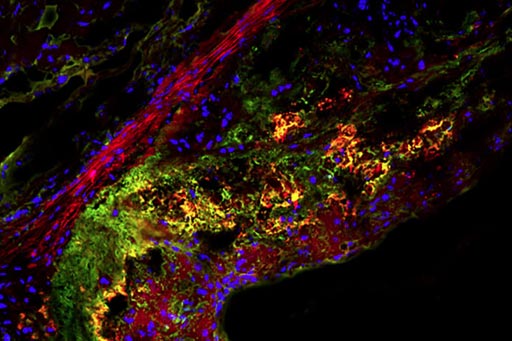Trehalose Boosts Macrophage Ability to Clear Plaques
By LabMedica International staff writers
Posted on 22 Jun 2017
Cardiovascular disease researchers working with mouse models have found that treatment with the sugar trehalose boosts the activity of the macrophages responsible for clearing the molecular and cellular debris that make up atherosclerotic plaques.Posted on 22 Jun 2017
Macrophages specialize in removing lipids and debris present in atherosclerotic plaques. However, as plaques grow, their size and complexity render macrophages unable to degrade exogenous atherogenic material and endogenous cargo including dysfunctional proteins and organelles. The decline in the autophagy-lysosome system that contributes to this situation is evidenced by disarray of key autophagy markers in both mouse and human atherosclerotic plaques.

Image: A photomicrograph of a cross section of a mouse aorta, the main artery in the body, with a large plaque. Straight red lines toward the upper left are the wall of the aorta. Yellow areas are where housekeeping cells called macrophages are clearing cellular waste (Photo courtesy of Ismail Sergin, Washington University School of Medicine).
Investigators at Washington University School of Medicine (St. Louis, MO, USA) reported that by boosting the activity of the macrophage protein transcription factor EB (TFEB), they could reverse the autophagy dysfunction of macrophages in plaques. TFEB is known to regulate many lysosomal genes, and by translocating to the cell nucleus, TFEB itself can be activated when the lysosome malfunctions. This serves to regulate both the abundance of lysosomes found in the cell and their ability to degrade complex molecules.
The investigators described in the June 7, 2017, online edition of the journal Nature Communications the ability of the natural sugar trehalose to act as an inducer of macrophage autophagy-lysosomal biogenesis and demonstrated the ability of trehalose to stimulate the plaque clearing properties of macrophage TFEB overexpression.
Trehalose is a non-reducing natural disaccharide (alpha,alpha-1,1-glucoside) synthesized endogenously by non-mammalian organisms such as insects, crustaceans, and certain plants. Present in high concentration in these organisms, trehalose is thought to provide protection against environmental stresses such as osmotic and temperature shocks by stabilizing biomolecules. The pharmaceutical industry uses trehalose as a stabilizer in numerous medicines. In the food industry, trehalose has been used as a sweetener because of its mild sweetness as compared to its other closely related non-reducing disaccharide sucrose. Owing to the ability of trehalose to induce autophagy and ameliorate various protein aggregation neurodegenerative diseases and the finding of TFEB as an autophagy inducer particularly of protein aggregates, the investigators became interested in evaluating the effects of trehalose in the induction of macrophage TFEB, autophagy-lysosomal biogenesis, and atherosclerosis.
Toward this end, they injected mice prone to atherosclerosis with trehalose. Following treatment, these animals displayed reduced plaque in their arteries. The sizes of the plaques measured in the aortic root were variable, but on average, the plaques measured 0.35 square millimeters in control mice compared with 0.25 square millimeters in the mice receiving trehalose, which translated into a roughly 30% decrease in plaque size. The effect disappeared when the mice were given trehalose orally or when they were injected with other types of sugar, even those with similar structures.
"We are interested in enhancing the ability of these immune cells, called macrophages, to degrade cellular garbage - making them super-macrophages," said senior author Dr. Babak Razani, assistant professor of medicine at Washington University School of Medicine. "In atherosclerosis, macrophages try to fix damage to the artery by cleaning up the area, but they get overwhelmed by the inflammatory nature of the plaques. Their housekeeping process gets gummed up. So their friends rush in to try to clean up the bigger mess and also become part of the problem. A soup starts building up - dying cells, more lipids. The plaque grows and grows."
"Trehalose is not just enhancing the housekeeping machinery that is already there," said Dr. Razani. "It is triggering the cell to make new machinery. This results in more autophagy - the cell starts a degradation fest. Is this the only way that trehalose works to enhance autophagy by macrophages? We cannot say that for sure - we are still testing that. But is it a predominant process? Yes."
Related Links:
Washington University School of Medicine








 (3) (1).png)





